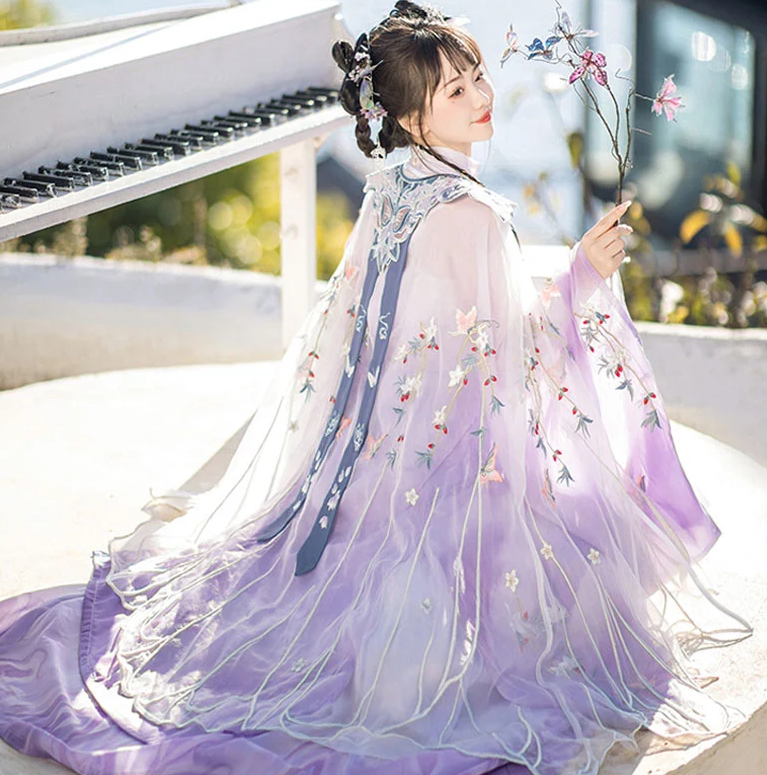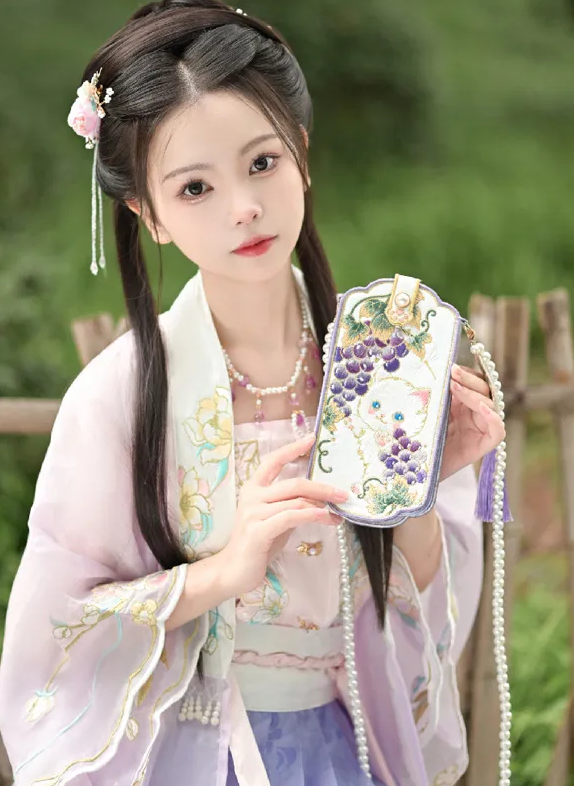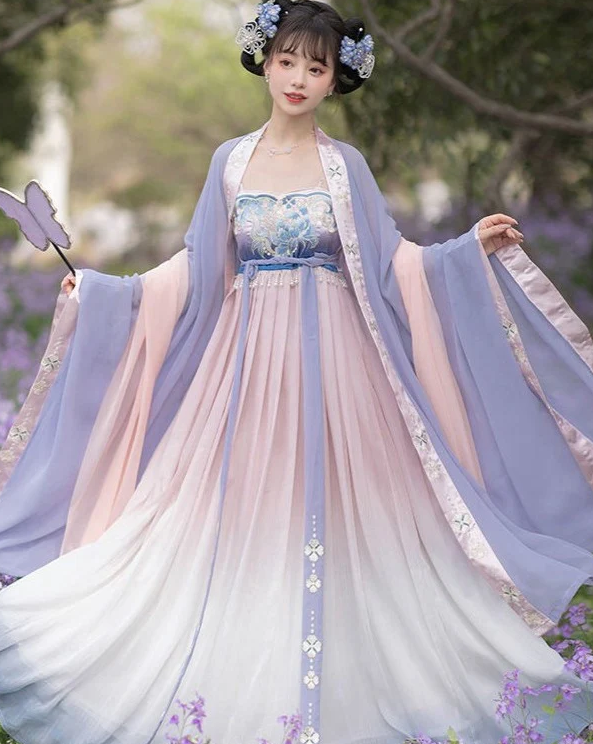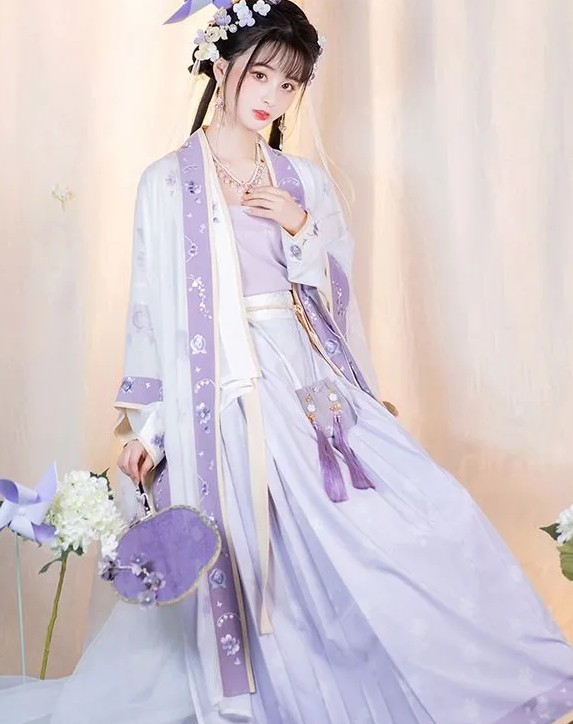Purple Hanfu embodies nobility and elegance, signifying wisdom, wealth, and spiritual depth in Chinese culture.
Introduction
The exploration into the world of Hanfu clothing takes us back to the rich tapestry of Chinese history and culture. One intriguing aspect of this traditional clothing is its diverse color palette, where each color holds distinct symbolic meanings. Among these colors, purple stands out as both visually captivating and symbolically profound. In this section, we will delve into what Hanfu is and explore the cultural and symbolic importance of the color purple in the context of Hanfu.

Definition of Hanfu
Hanfu refers to the traditional clothing of the Han Chinese people, dating back to the Han Dynasty over two millennia ago. These garments have evolved over time, but they still hold cultural significance and are an integral part of Chinese heritage. From ancient rites to modern ceremonies, Hanfu continues to be a visual representation of Chinese culture, carrying aesthetic, historical, and social values.
Significance of the Color Purple
The color purple holds special symbolism in various cultures, including Chinese. Historically, it has been associated with royalty, nobility, and spirituality. In the context of Hanfu, purple often represents wisdom, wealth, and high social status. It’s a color that’s not commonly worn daily but is reserved for special occasions or ceremonies. As we will see, the combination of the color purple with Hanfu is not only visually striking but also laden with various cultural connotations.
The Cultural Roots of Hanfu
Delving into the cultural roots of Hanfu takes us on a fascinating journey through Chinese history. From its inception in ancient dynasties to its resurgence in contemporary society, Hanfu is more than just clothing; it is a reflection of cultural values, social norms, and historical continuity. Understanding the historical and modern contexts of Hanfu helps us appreciate the nuances in its design, including the use of specific colors like purple.
Historical Background
The origin of Hanfu dates back to the Han Dynasty, although variations of these traditional garments existed even before that period. Hanfu served as a means of establishing cultural identity, often influenced by the Confucian ideals of propriety and ritual. Over the centuries, Hanfu underwent changes influenced by different dynasties and external cultures. However, core elements such as the crossed collar and sash remained consistent, symbolizing the endurance of traditional Chinese culture.
Hanfu in Modern Society
Fast-forward to the present, and you’ll find that Hanfu has made a significant comeback, especially among the younger generation. While it might not be everyday wear for most, it has become increasingly popular in various contexts, from cultural festivals to cosplay events. Modern adaptations of Hanfu often incorporate newer fabrics and styles but strive to retain the garment’s cultural essence. Social media platforms have also played a crucial role in the Hanfu revival, providing a space for enthusiasts to share styling tips, historical insights, and even the significance of specific colors like purple in their outfits.
The Color Purple: A Deep Dive
Taking a closer look at the color purple can be likened to plunging into a well of cultural, social, and historical significances. In the context of Hanfu, the color holds its own weight of implications, resonating both with its historical ties and its contemporary allure. In this section, we’ll examine the symbolic layers of purple in Chinese culture and its specific relevance in textiles and fabrics used in Hanfu.
Symbolism in Chinese Culture
In Chinese culture, the color purple is rich in symbolism. Often associated with nobility, wealth, and spirituality, purple holds a revered place in Chinese art, literature, and traditional ceremonies.
Purple in Textiles and Fabrics
The textile industry has its own set of traditions when it comes to the use of color. Purple, being a less common but highly respected color, often finds itself featured in luxury fabrics like silk. The dye used for creating the color purple was historically extracted from rare sources, making garments of this color expensive and thus reserved for special occasions or affluent individuals. In modern times, the color is more accessible but still often used in higher-end Hanfu designs, especially for festive or ceremonial purposes. The fusion of purple in Hanfu textiles today is a nod to its rich history, a blend of the past and the present in one vibrant hue.
The Intersection of Purple and Hanfu
When the deep symbolism of the color purple meets the historical richness of Hanfu, the result is a garment imbued with layers of meaning. This intersection is not a mere blending of color and fabric but a nuanced integration of cultural significance, social implications, and aesthetic beauty. In this section, we explore the traditional uses of purple in Hanfu and how this age-old tradition is being adapted and renewed in today’s world.
Traditional Uses
Purple, with its regal and spiritual undertones, was traditionally a color worn by nobility or during significant ceremonies in ancient China. When used in Hanfu, the color signified high social status and was often seen in the garments worn at the imperial courts. Purple Hanfu was generally made of luxurious fabrics like silk and adorned with intricate patterns and embroideries. Its use wasn’t widespread among commoners due to the scarcity and expense of purple dyes. In short, traditional purple Hanfu represented the zenith of cultural artistry, accessible only to the elite.

Modern Adaptations
Modern interpretations of purple Hanfu are diverse, thanks to the democratization of fashion and the widespread availability of materials. The significance of purple remains, but the color is now accessible to the masses. Purple Hanfu today is commonly seen at cultural events, cosplay gatherings, and even as high-fashion pieces. The contemporary fashion scene has even adopted purple Hanfu as a bold statement piece, indicating a break from the traditional norms yet keeping the cultural significance intact. Designers are experimenting with various shades of purple, textures, and fabric blends to produce Hanfu that caters to modern tastes while paying homage to its historical roots.
Types and Styles of Purple Hanfu
The elegance and profundity of the color purple find a perfect canvas in the diverse world of Hanfu styles. As varied as the meanings behind the color are the types of Hanfu that incorporate it. Whether you’re attending a festival, going about your daily activities, or participating in a ceremonial event, there’s a purple Hanfu tailored for the occasion. In this section, we’ll break down the types and styles of purple Hanfu that are commonly seen today.
Festive Purple Hanfu
When it comes to celebratory occasions like Lunar New Year, Mid-Autumn Festival, or weddings, festive purple Hanfu takes center stage. These garments are often crafted from luxurious materials like silk and are adorned with golden embroidery, intricate beadwork, and sometimes even gemstones. The purple hue serves as a backdrop for showcasing prosperity and happiness, making it an ideal choice for festive events.
Everyday Purple Hanfu
In contrast to the opulence of festive Hanfu, everyday purple Hanfu is more toned down but retains its distinctive appeal. Typically made from more practical fabrics like cotton or linen, these are the Hanfu you’ll find being worn casually or even in the workplace. Everyday purple Hanfu tends to feature lighter shades, like lavender, which are easier on the eyes and more versatile for daily wear. Such Hanfu might include casual robes, tunics, and skirts, providing comfort and style while subtly nodding to cultural heritage.
Ceremonial Purple Hanfu
Purple Hanfu reserved for ceremonies takes the color’s symbolism to the highest level. Fine silks, elaborate embroideries, and sophisticated layering are the norm. The shade of purple chosen usually leans towards deeper, richer hues to signify the importance and solemnity of the occasion. In these settings, the color stands for the highest virtues—wisdom, nobility, and spirituality—embodied in the form of a garment.

Symbolic Meanings Behind Purple Hanfu
The aesthetic allure of purple Hanfu goes beyond the visual; it dives deep into a realm of symbolism that holds significant cultural and social implications. This connection is not mere happenstance but an intricate tapestry woven through centuries of tradition and history. In this section, we explore the multifaceted meanings behind purple Hanfu that make it far more than a beautiful garment.
Cultural Significance
Purple has a long-standing cultural significance in Chinese history. In the realm of Hanfu, purple often symbolizes the loftiest of values, such as wisdom, spirituality, and nobility. Its use in traditional ceremonies, imperial courts, and festive celebrations only underscores its importance as a color of higher virtues. Additionally, purple’s historical exclusivity adds to its cultural weight. Once a color restricted to the upper echelons of society, its modern democratization has not diminished its cultural richness but expanded its scope, making it a symbol of both historical continuity and cultural evolution.
Social Implications
In modern society, the color purple has implications that stretch beyond its traditional symbolism. Wearing purple Hanfu in the contemporary context can indicate a range of social markers, from personal style to cultural pride. On one hand, donning purple Hanfu at cultural festivals or significant events highlights a deep respect for heritage and tradition. On the other hand, integrating purple into everyday wear may serve as a fashion statement or a form of self-expression. In this way, the color bridges the gap between history and modernity, serving as a versatile element that can both adhere to tradition and adapt to current social dynamics.
The Fashion and Aesthetics of Purple Hanfu
While the color purple’s traditional and symbolic roots in Hanfu are profound, its contemporary appeal is equally compelling. Purple Hanfu has emerged as a fashionable choice for people looking to express their unique style while honoring cultural heritage. This section delves into the styling tips and popular trends surrounding purple Hanfu that make it a captivating choice in today’s fashion landscape.
Styling Tips
The aesthetic versatility of purple makes it a color that can be styled in numerous ways. For a subdued, elegant look, consider pairing a light purple Hanfu with muted accessories like beige or light gold ornaments. When attending a formal event, opt for deeper shades of purple adorned with intricate embroideries and high-quality fabric like silk or brocade. The key is to understand the occasion and select the shade and style of purple Hanfu that complements it best. When done correctly, purple Hanfu not only elevates your style but also resonates with cultural significance.

Popular Trends
As Hanfu gains popularity in global fashion, new trends keep emerging, and purple Hanfu is no exception. Some of the popular trends include the use of gradient purples, layering different shades for a mesmerizing effect. Ombre patterns that transition from light to dark purple have also caught the public’s eye. Designers are incorporating modern elements like belts, capes, and asymmetric designs to make purple Hanfu appealing to younger audiences. Moreover, the blend of traditional motifs and modern fabrics has led to a renaissance of sorts for purple Hanfu, making it a sought-after choice both in and outside of China.